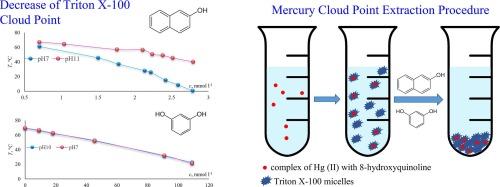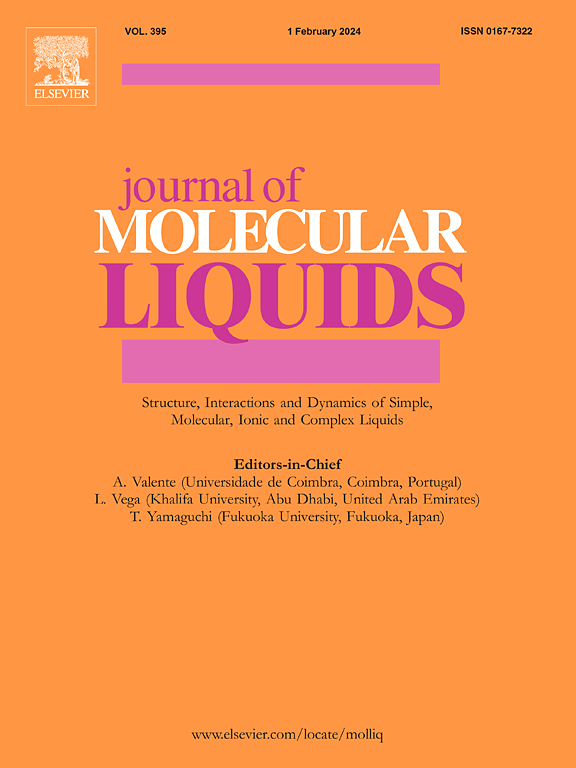Clouding of Triton X-100 solutions in the presence of resorcinol or β-naphthol and their application for mercury cloud point extraction
IF 5.3
2区 化学
Q2 CHEMISTRY, PHYSICAL
引用次数: 0
Abstract
The clouding behavior of Triton X-100 solutions was investigated in the presence of resorcinol or β-naphthol. Both agents can effectively decrease the cloud point of Triton X-100 solutions. Resorcinol is active over a wider pH range, while β-naphthol is required at concentrations 10–50 times lower than resorcinol. It was also shown that about 60–70 % of β-naphthol transfers to the micellar phase, whereas resorcinol barely enters the micellar phase (about 10–15 %). Thermodynamic parameters of the clouding process were also calculated, revealing no significant differences between thermodynamic parameters for these two substances studied. Based on the results obtained, we assume different mechanisms of phase separation by these agents. Using the systems studied, mercury cloud point extraction was successfully carried out with 8-hydroxyquinoline as a ligand. The optimal parameters for extraction were determined as follows: pH of 8 (β-naphthol) and 6 (resorcinol), ligand concentration of 0.03–0.26 mmol L−1, and surfactant concentration of 1.7 g L−1.

间苯二酚或 β-萘酚存在时 Triton X-100 溶液的浊化及其在汞浊点萃取中的应用
研究了间苯二酚或 β-萘酚存在时 Triton X-100 溶液的浊化行为。这两种制剂都能有效降低 Triton X-100 溶液的浊点。间苯二酚在更宽的 pH 值范围内具有活性,而 β-萘酚需要的浓度比间苯二酚低 10-50 倍。研究还表明,约有 60-70% 的 β-萘酚转移到胶束相,而间苯二酚几乎不进入胶束相(约 10-15%)。我们还计算了混浊过程的热力学参数,结果表明所研究的这两种物质的热力学参数没有明显差异。根据所获得的结果,我们假定这些制剂的相分离机制不同。利用所研究的体系,以 8-羟基喹啉为配体成功地进行了汞浊点萃取。确定的最佳萃取参数如下:pH 值为 8(β-萘酚)和 6(间苯二酚),配体浓度为 0.03-0.26 mmol L-1,表面活性剂浓度为 1.7 g L-1。
本文章由计算机程序翻译,如有差异,请以英文原文为准。
求助全文
约1分钟内获得全文
求助全文
来源期刊

Journal of Molecular Liquids
化学-物理:原子、分子和化学物理
CiteScore
10.30
自引率
16.70%
发文量
2597
审稿时长
78 days
期刊介绍:
The journal includes papers in the following areas:
– Simple organic liquids and mixtures
– Ionic liquids
– Surfactant solutions (including micelles and vesicles) and liquid interfaces
– Colloidal solutions and nanoparticles
– Thermotropic and lyotropic liquid crystals
– Ferrofluids
– Water, aqueous solutions and other hydrogen-bonded liquids
– Lubricants, polymer solutions and melts
– Molten metals and salts
– Phase transitions and critical phenomena in liquids and confined fluids
– Self assembly in complex liquids.– Biomolecules in solution
The emphasis is on the molecular (or microscopic) understanding of particular liquids or liquid systems, especially concerning structure, dynamics and intermolecular forces. The experimental techniques used may include:
– Conventional spectroscopy (mid-IR and far-IR, Raman, NMR, etc.)
– Non-linear optics and time resolved spectroscopy (psec, fsec, asec, ISRS, etc.)
– Light scattering (Rayleigh, Brillouin, PCS, etc.)
– Dielectric relaxation
– X-ray and neutron scattering and diffraction.
Experimental studies, computer simulations (MD or MC) and analytical theory will be considered for publication; papers just reporting experimental results that do not contribute to the understanding of the fundamentals of molecular and ionic liquids will not be accepted. Only papers of a non-routine nature and advancing the field will be considered for publication.
 求助内容:
求助内容: 应助结果提醒方式:
应助结果提醒方式:


